
Medieval Market
By 1300 the provision market & various subsidiaries covered a huge area stretching from what is now the line of Guildhall
Hill & London Street almost as far as St Stephen’s Church. Like most fairs & markets it was held under license from the King
as the right to trade and receive revenues was part of the Royal prerogative. However, this was about to change. Fortuitously
in 1341 King Edward III visited the city for a jousting tournament just as the building of the defensive city walls had been
completed “…for the honour of the King” In gratitude the King granted the franchise of the Market to the city’s rulers in
perpetuity – a franchise which survives to this day!
- Trade
- Subsidiary Markets
- Decline & Recovery
- Play & Punishment
- The Guildhall
- St Peter Mancroft
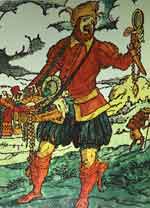 In Medieval times the majority of local trade would have taken place at fairs & town markets. Norwich Market, held on Mancroft, is believed to have taken place on Wednesdays & Saturdays (although for a brief period a daily market was held).
Norwich Market covered a huge area. Its size related to a number of factors :
In Medieval times the majority of local trade would have taken place at fairs & town markets. Norwich Market, held on Mancroft, is believed to have taken place on Wednesdays & Saturdays (although for a brief period a daily market was held).
Norwich Market covered a huge area. Its size related to a number of factors :
- Norwich was one of the biggest and riches towns in the country
- It had skilled workers i.e over 130 trades and occupations are recorded in 13th century Norwich
- As it is now, Norwich was a central trading point for its hinterland
- Norwich was a centre for foreign imports.
Thus livestock, cereals, leather, salt (the essential Medieval preservative) cloth and metal work were all sold on the market along with foreign imports . Areas around the open market would have been allotted to specific crafts and trades. Of particular interest is the huge amount of space given over leather working which reflects its relative dominance in this period.(see Market Wares for details)
An area below the market rows (the "Lower Market") was kept clear of permanent buildings for the use of country smallholders. Any peasant could take food to sell at the market, though he had to pay a tax to spread his goods out on the ground. Pedlars, merchants, drovers of cattle, sheep & geese all came & sold a vast range of goods including : cheese, eggs, pots, pans, candles, knives, shoes & cloth. The name Pudding Lane (leading down from Market Place) derives from the “peds” or baskets used by traders who did not have stalls.
Norwich market was huge. The main market place became so crowded that subsidiary markets developed, many of
which gave their names to Norwich streets thus :
- Horses were sold outside the churchyard of St Stephen’s, now Rampant Horse Street which took its name from an inn that once stood near the Horse Market
- The Swine market, was held originally on All Saints Green, before moving to Hog Hill (now Orford Hill)
- The Timber Market eventually gave its name to Timber Hill but not until the 16th century. Prior to this it had a number of names including "Old Swine Market Hill" at the end of the 13th century - as it led up to the swine market.
- The Maddermarket, where dye for the weaving industry was sold, did not give it's name to a street but it is still remembered in buildings e.g. The Maddermarket Theatre, St John Maddermarket church.
- The Haymarket gave its name to the street where it was located. Today "The Haymarket" runs from Brigg Street to the Junction of White Lion Street and Gentleman's Walk
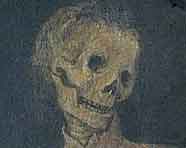 Following the appearance of The Black Death in Norwich in 1349, the city lost at least two fifths of its population. In all areas of the city the effect was devastating. A record of 1357 lists shops and market stalls that had had been left empty and fallen into ruin whilst after the plague and famine of 1369, the overcrowded churchyard at St Peter Mancroft was extended southwards by taking in part of what was the cloth market.
Following the appearance of The Black Death in Norwich in 1349, the city lost at least two fifths of its population. In all areas of the city the effect was devastating. A record of 1357 lists shops and market stalls that had had been left empty and fallen into ruin whilst after the plague and famine of 1369, the overcrowded churchyard at St Peter Mancroft was extended southwards by taking in part of what was the cloth market.
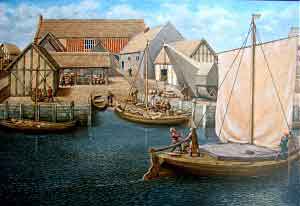
The presence of plague meant a more careful regulation in the price of corn. The Mayor, as clerk of the market, regulated the price of corn and beer and other commodities to ensure that prices were kept at a reasonable level. Tradesmen accused of selling bad or underweight food were brought before a special jury and, if found guilty, severely fined.
However, the city was resilient and within a decade there were signs of recovery.The rich prosperous merchant classes were a powerful influence on government. Probably at their instigation by 1397 the city had not only acquired many more shops and stalls but also the staithes on King Street. At the same time they issued a decree that all goods coming into Norwich by market must be landed on these staithes. Such measures served to tighten the monopoly of local merchants and increase their wealth.
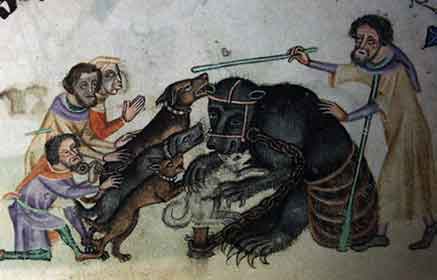
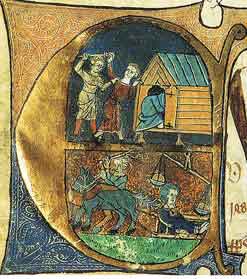 Stallholders were subject to a number of laws. Thus, for example, traders (as opposed to merchants) weren’t allowed to forestall i.e. sell their wares between the city walls and the market place, which would have been done to avoid paying taxes.
Stallholders were subject to a number of laws. Thus, for example, traders (as opposed to merchants) weren’t allowed to forestall i.e. sell their wares between the city walls and the market place, which would have been done to avoid paying taxes.Tradesmen, accused of selling bad or underweight food were brought before a special jury and, if found guilty punished. Although such punishment was normally in the form of a fine it could have resulted in a spell in the stocks or even worse as illustrated in this medieval manuscript (left) . Here a baker who violated weight regulations is being dragged though the city streets on a sled with the offending bread tied around his neck.
As in later times the market place was a perfect site for administering public punishments such as being placed in the stocks. Being a central open space it was also an entertainment venue were medieval mystery plays & bear baiting could be viewed.
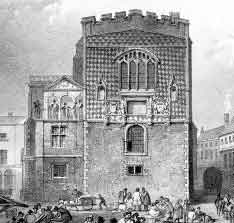
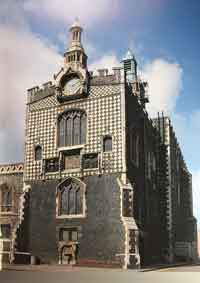 In
1404 King Henry IV gave a new charter to the city whereby Norwich became a county in its own right and could elect a Mayor,
24 Aldermen, and a full complement of councillors. Civic government had outgrown the market Tollhouse and so work was started
on a new Guildhall. Building commenced in 1407 on the site of the old Norman tollhouse, next to the market – the commercial
and administrative centre right at the hub of city life – remaining so until the new City Hall was built in 1938. It is by
far the largest building of its kind in England outside London.
In
1404 King Henry IV gave a new charter to the city whereby Norwich became a county in its own right and could elect a Mayor,
24 Aldermen, and a full complement of councillors. Civic government had outgrown the market Tollhouse and so work was started
on a new Guildhall. Building commenced in 1407 on the site of the old Norman tollhouse, next to the market – the commercial
and administrative centre right at the hub of city life – remaining so until the new City Hall was built in 1938. It is by
far the largest building of its kind in England outside London.
The chequerboard design at the east end of the Guildhall is a pun on the sign of tax collectors – simple and clear for the majority of people who couldn’t read. Tolls would be calculated on a chequered cloth – from where we get the term “Exchequer”. Scribes would sit in lean-to booths against the walls, writing and reading letters and documents for those who couldn’t. Stocks, pillories and a “cage” were situated at the eastern end of the Guildhall. It was a “Community Project”, built with pressed labour, working from 5am to 8pm each day. Only the master mason and skilled workers were paid. Building costs are estimated at £400/500 in medieval money (when the income of the city was only £120 per year.) It is built of flint, but the corners are of stone because flint can’t be “squared off”. Over the centuries the Guildhall has also housed courts, prisons, a cloth hall, the Chief Constable and also the city’s fire engine (horse-drawn).
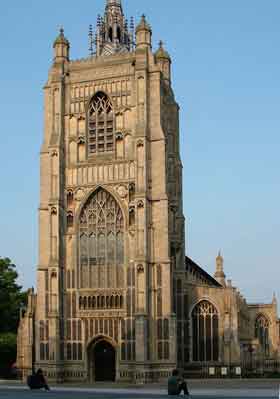 Less than 30 years after the building of The Guildhall a second distinctive building which still survives today was built adjacent to the market place : St Peter Mancroft Church.
Less than 30 years after the building of The Guildhall a second distinctive building which still survives today was built adjacent to the market place : St Peter Mancroft Church.
It was largely financed by the merchants who had amassed great wealth. Unlike the Guildhall, that was built from local flint and to a budget, this was a building designed to flout the wealth of its benefactors. Dedicated to St Peter & St Paul it replaced the Norman church built by Ralph de Guader. Despite its size & grandeur it was built in 25 years from 1430 - 55.
The church continues to have links with the market. Even today all stallholders have the right to be both married & buried in the church.